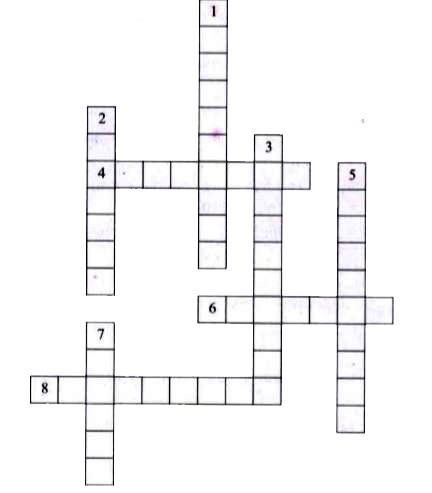Two organisms occupying a particular geographical are ( say desert ) show similar adaptive strategies. Taking examples, descrbe the phenomenon.
This phenomenon indicated in the question is convergent evolution where by organism, not closely related, evolve similar traits independently as a result of adaptation to similar environment. , e.g.,
(i) Streamlined shape of sharks and dolphins. The former is a fish, while dolphin is a mammal, but both of them depend on swift movement through the water, so a stremlined shape is essential. Thus, it is the similar habitat that resulted in selection of similar adaptive features in different groups of organisms, but toward the same function.
(ii) Spines ( modified leaves ) and thorns ( modified stems ), both look similar and provide protection to the plant, the plants to which they belong are distantly related.
Topper's Solved these Questions
Similar Questions
Two long needies are attached to the poles of a horse shoe magnet. Show on a diagram the position occupied by the needles and name the phenomenon which comes into play
View Solution(a) Name the phenomenon which helps fresh water unicellular organisms (e.g., Amoeba) continuosuly gain water in their bodies. Also name the mechanisms by which these organisma throw out exces of water from their bodies.
(b) Give at least two examples in plants where similar phenomenon in used to gain water.View Solution
Knowledge Check
- Question 1 - Select One
in a particular geographical area. If leopards and lions feed on similar prey, they may show ……………. .
Ainterspecific struggleBintraspecific struggleCcommenslismDmutualism - Question 2 - Select One
Organisms occupying similar ecological niche but different geographical areas of distribution are called as
AEdge speciesBEcological equivalentsCEcocolinesDInquilines - Question 3 - Select One
Two species of different geneology show resemblance due to similar adaptation, the phenomenon is
AConvergent evolutionBDivergent evolutionCMicro-evolutionDCo-evolution
Complete the crossword puzzle using the clues given below:
Across
4. change in the inherited features of an organism over time 6. survival of individuals with the most adapted _____traits, selection 8. appearance of an inherited trait that makes an individual different from other members of the same species
Down
1. geographic speciation is also called 2. a group of organisms whose members look similar and successfully reproduce among themselves 3. a group of organisms of one species that lives in an area 5. a slow change of one species to another new species 7. developed the theory of evolution by natural selection
 View Solution
View SolutionTwo species of different geneology show resemblance due to similar adaptation, the phenomenon is
View SolutionWhen two related populations occupy geographically or spatially separate areas, they are called.
OR
The organisms separated by geographical barriers are termedView SolutionGiven below are two statements each with one or more blanks. Select the option which correctly fills up the blanks in the statements.
Statements:
In a mixed population, those that can better-adapt, (i) and increase in population size. No variant is
(ii) wiped out.
Similarly, excess use of herbicides, pesticides, etc., has only resulted in selection of resistant varieties in a much
(iii) time scale. This is also true for microbes against which we employ antibiotics or drugs against eukaryotic organisms/cell. Hence, resistant organisms/cells are appearing in a time scale of months or years and not centuries. These are examples of evolution by (iv) action. This also tells us that evolution is not a (v) process in the sense of determinism. It is a (vi) process based on chance events in nature and chance
(vii)in the organisms.View SolutionRead the passage given below and answer the following questions:
Some colloids are stable by their nature, i.e., gels, alloys, and solid foams. Gelatin and jellies are two common examples of a gel. The solid and liquid phases in a gel are interdispersed with both phases being continuous. In most systems, the major factor influencing the stability is the charge on the colloidal particles. If a particular ion is preferentially adsorbed on the surface of the particles, the particles in suspension will repel each other, thereby preventing the formation of aggregates that are larger than colloidal dimensions. The ion can be either positive or negative depending on the particular colloidal system, i.e., air bubbles accumulate negative ions, sulphur particles have a net negative charge in a sulphur sol, and the particles in a metal hydroxide sol are positively charged. Accumulation of charge on a surface is not an unusual phenomenon-dust is attracted to furniture surfaces by electrostatic forces. When salts are added to lyophobic colloidal systems the colloidal particles begin to form larger aggregates and a sediment forms as they settle. This phenomenon is called flocculation, and the suspension can be referred to as flocculated, or colloidally unstable. If the salt is removed, the suspension can usually be restored to its original state, this process is called deflocculation or peptization. The original and restored colloidal systems are called deflocculated, peptized, or stable sols.
Why does a small amount of salt have such a dramatic effect on the stability of a lyophobic colloidal system? The answer lies in an understanding of the attractive and repulsive forces that exist between colloidal particles. Van der Waals forces are responsible for the attractions, while the repulsive forces are due to the surface charge on the particles. In a stable colloid, the repulsive forces are of greater magnitude than the attractive forces. The magnitude of the electrical repulsion is diminished by addition of ionized salt, which allows the dispersed particles to aggregate and flocculate. River deltas provide an example of this behaviour. A delta is formed at the mouth of a river because the colloidal clay particles are flocculated when the freshwater mixes with the salt water of the ocean
(source: Sarquis, J. (1980). Colloidal systems. Journal of Chemical Education, 57(8), 602. doi:10.1021/ed057p602 )
Colloidal solutions are stable due to:View Solution

